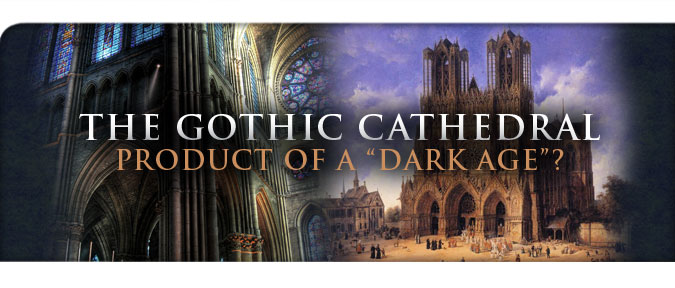
The term Gothic (pertaining to the Goths, a Germanic barbarian tribe) was coined during the Renaissance in depreciation of medieval art.
But the designation backfired. The “barbaric” art won out, and the epithet not only ceased to be depreciatory but was in fact ennobled. This is so much the case that there are few today who, contemplating Gothic art, will call to mind or even realize the sarcastic etymology as they are absorbed by the sublime beauty of the stained glass and the delicate veins of stone.
Among everything developed by the Middle Ages – and subsequently incorporated into the millennial treasure of Christian civilization – what perhaps speaks most to the soul of contemporary man are the Gothic cathedrals.
In our gray, agitated times the symbolic aspects and the beauty of those monuments of the Faith are still able to break through the layers of spiritual soot that have descended upon today’s megalopolises and, as an intense beam of golden light, to arouse the sense of the marvelous in countless souls.
Even if there were no historical monument to represent medieval social, intellectual, and moral life to us, the churches of that age would tell us about it like words indelibly cut into stone and engraved in the traditions of nations. “If nothing of medieval Christianity had survived excepting the cathedrals,” says Daniel-Rops, “they alone would tell us all, or nearly all, that matters about the period in question: its spiritual life, its moral code, its day-to-day existence, its methods of work, its literature, and even, to some extent, its political beliefs.”
Beautiful wallpaper downloads: Gothic Cathedrals
Faith and Love
In the Gothic churches, medieval man invested the best of his soul, art found its most complete expression, and the theologian and the architect united their talents in an act of praise to God. This is why the Gothic cathedral, a symbol of faith, is also a symbol of love. Everyone worked on it.: the people contributed their hands; the bourgeois, his money; the lord, his land; and the artist, his genius.
In examining the esthetic principles applied in the conception of the Gothic cathedral and the rich symbolism that underlies its architectural elements, one is in fact analyzing the mentality of those who built it and, by extension, the society that engendered the human type that was capable of such a feat. Through these monuments that so defy time, we may understand key aspects of medieval Christianity, which in large measure realized the ideal of Christian civilization.
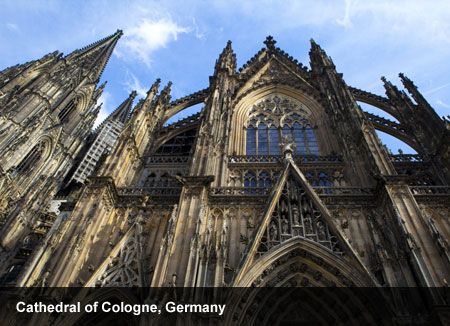
Reflections of Uncreated Beauty
“Faciamus hominem ad imaginem et similitudinem nostrum” – Let Us make man to Our image and likeness (Gen. 1:26).
The Middle Ages never ceased repeating that any form is beautiful in the measure that it bears some resemblance to divine beauty. Nevertheless, medieval man knew that beauty, so sought after by him, must not be contemplated only in its immobility, as figée, like the Orientals represented it in many of their works, or “imprisoned” as in contemporary museums. It must be seen as dynamic, communicative, and full of life. This is why the Gothic church attained the height of its beauty in the great liturgical feasts, such as Christmas and Easter, or during important civic-religious solemnities like the coronation of the Kings of France in the Cathedral of Rheims.
In order to express and communicate some truths, man must oftentimes resort to symbols that reach the soul’s deepest recesses and reflect certain intangible, transcendental realities, which written or spoken words cannot convey. Through such symbols we become responsive to the appeal of the marvelous, and our knowledge can be transformed into love. In Latin, this is called the via pulchritudinis (the way of beauty).
The pointed-arch architecture offered a fitting décor for the splendors of liturgical ceremonial and the ethereal, harmonious melodies of Gregorian chant. The richness of priestly vestments, the serene pomp of the liturgy, the intense emotion expressed by the organ, the touching simplicity of plainsong -- everything, in fine, contributed to envelop the faithful in a mystical atmosphere.
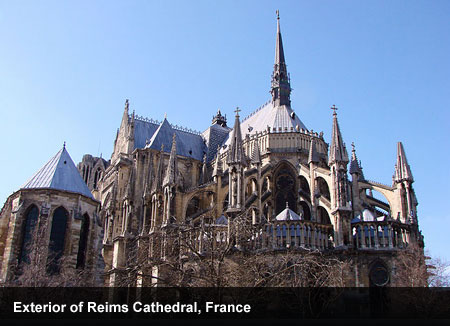
The Boldness of Great Heights
Harmonious proportions are so evident inside the Gothic edifices that one seems to hear something of an original melody; one perceives a symphony in stone. The whole building seems to have been relieved of the weight of matter, of everything that binds it to the earth. The pillars rise high and flexibly to blend with the vaulted ceiling through the ribs. Typically rising as a living force from the floor on the face of the pillars, the ribs support large vaults with seeming effortlessness.
What characterized the Gothic style is the upward thrust, the ascent toward heaven, the soaring flight of columns and slender spires toward infinity.
The medieval architects, building their cathedrals on solid foundations, could afford the most impressive boldness without being foolhardy. Hence the vertiginous flight toward infinity of the columns and steeples, such as those of the Cathedral of Cologne (515 ft.) and the fortress-cathedrals of France’s southern region of Languedoc. Still others, the Cathedral of Strasbourg for one, are built on marshy land or above subterranean streams.
Beautiful wallpaper downloads: Gothic Cathedrals
Stained-glass Windows; Veritable Jewels
Attracted by daring arches, steeples, and Gothic towers, medieval man also retained a love of light. This explains the great concern of the architects to build ever more spacious churches that would allow for the installation of immense windows through which sunlight, temp0ered by the stained-glass polychromy, might flood the enclosure.
The authentic medieval stained-glass window is not a painting on glass but rather a translucent painting made of glass, that is, a patchwork of colored glass held together by grooved strips of lead. It was a difficult, refined art that simultaneously demanded high technical knowledge and artistic skill.
There, between the floor and the ceiling, as thought between the earth and heaven, those veritable jewels of glass suggest a paradisiacal grandeur that seems to surpass the building itself. That is the case of the celebrated rose windows of Notre Dame of Paris and the Cathedral of Chartres, which perpetuate for centuries on end the splendor of medieval art at its most sublime.
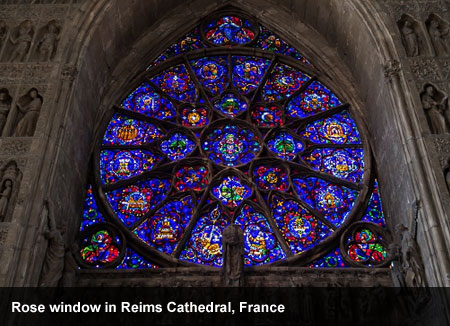
Let There Be Light
The whole creation is manifested to us through light. The rose window, a circle of light held high up in the midst of darkness, is the perfect representation of God’s creating command, “Let there be light.”
Every rose window is a symbol, a figure, of the creation. The concentric circles which made up the first rose windows were idealized models of the universe and of the globe, which is at the center of the circle.
The Gothic rose windows also symbolize the loftier aspirations of man; namely, to know the order established by God, to be one with Him, and forever to become His co-creator. The rose windows make it possible for man to obey the injunction of Psalm 45: “Be still, and know that I am God.”
The stained-glass windows, which peasants, as it were, read like a book, remain as yet not fully interpreted by our scholars. The faces that formerly a child could have pointed out by their names sometimes escape our efforts of identification.
The Blossoming of A Style
Gothic architecture did not originate as a consequence of the decadence of any previous art or style; it was rather the product of a new civilization that was then forming and that developed new esthetic standards, thought always retaining the best contributions fo Ronanesque style.
The Gothic style cam e about in consequence of a movement born in Ile-de-France, the true geographic nucleus of this form of architecture, and from thence it radiated to all Europe, adding local characteristics to its basic elements.
From France, the new style passed over to England with the master William of Sens, who was engaged for the reconstruction of Canterbury Cathedral. In Germany, the Gothic influence was felt later because Romanesque architecture still flourished there as late as the twelfth century. Only in the thirteenth century did the lancet-arch style reach Italy and the other countries of southern Europe.
Initially, the Gothic style was essentially religious. Civil edifices remained Romanesque. It was only later that the Gothic spread to palaces and public buildings, and then with incredible plasticity.
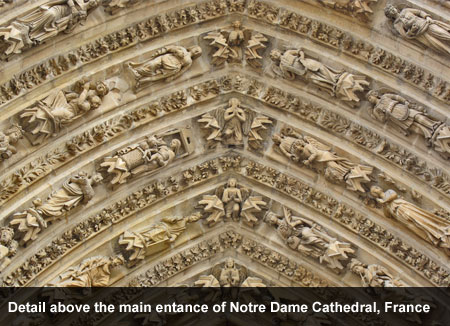
The Bible of the Poor
The thrust of the minds that conceived the Gothic style did not end in the mere esthetic desire of discovering a new form of artistic expression. Aiming beyond the pulchrum, medieval artists endeavored to represent also the verum – the truthful. Thus church architecture was conceived s o as to aid in the instruction of the faithful. Statuary in the lancet-arch art, for example, became not only decorative but also a means of spiritual expression and even catechetical instruction.
And Ongoing Miracle
Upon close examination of the Gothic cathedral, one is tempted to call it a miracle, the miracle of those columns that are never in rigorous alignment but nevertheless support the weight of the edifice; the miracle of those seemingly swirling vaults that criss-cross, turn, and cap off ever higher naves; the miracle of those walls with gaping openings, oftentimes with more glass that stone; finally, the miracle of the whole edifice, a wonderful synthesis of faith, inspiration, and piety.

No comments:
Post a Comment